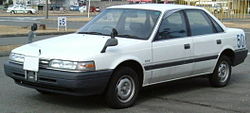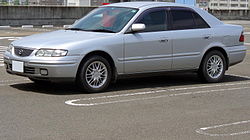- Mazda Capella
-
Mazda Capella 
Manufacturer Mazda Production 1970-2002 Successor Mazda Atenza/Mazda6 Class Compact (1970-1987)/Mid-size (1988-2002) The Mazda Capella is a midsize family car manufactured by Mazda Motor Corporation from 1970 to 2002. Sold in the Japanese Domestic Market under the Capella name, the vehicle was also commonly known in other major markets as the 626. Mazda's partner at the time, Ford Motor Company would also use the Capella platform to create the Ford Telstar and Ford Probe.
Designed to compete against Japanese midsize stalwarts such as the Honda Accord and Nissan Bluebird, the Capella would be succeeded by the Mazda Atenza in 2002.
Contents
1970
Mark 1 
Also called Mazda 616
Mazda 618Production 1970 — 1977 Body style 2-door coupe
4-door sedanLayout FR layout Engine 1.6 L I4 Transmission 4-speed manual Wheelbase 97 in (2,464 mm) Length 163 in (4,140 mm) Width 62 in (1,575 mm) Height 56 in (1,422 mm) Related Mazda RX-2 The first Capella was introduced in 1970 and lasted until 1974. It was powered by a 4 cylinder SOHC valve engine displacing 1.6 L (1586cc). Bore was 78 mm and stroke was 83 mm. Output was 104 hp (77 kW) and 106 ft·lbf (144 Nm).
This generation was sold in export markets as the Mazda 616 in sedan and, for some markets, coupe configurations.
An optional Mazda Wankel engine was offered and known as the Mazda RX-2 outside Japan.
The RX-2 was assembled under contract in New Zealand from 1972 for Mazda New Zealand by Motor Industries International in Otahuhu, South Auckland. It was the first and only rotary-engined car ever to be assembled in the country and was made as both a sedan, with manual or automatic transmission and a manual-only coupe. The 616 was also built but was much less popular.
The Capella received a minor facelift in 1974.
616/618 (USA)
The 616 was a major component of Mazda's United States expansion in 1971, having been preceded by its rotary brother, the RX-2, the previous year. It featured the 1.6 L (1586 cc) engine, which was later used in the 808. The American Capella was updated and renamed the next year. The 1972 618 had a larger 1.8 L (1796 cc) engine. Lasting just one year, the 618 nameplate was not used again in the United States and the only Capella for 1973 was the RX-2.
1978
Mark 2 Production 1978 — 1982 Body style 2-door coupe
4-door sedanLayout FR layout Engine 1.6 L F/MA I4
2.0 L F/MA I4Wheelbase 2,470mm Length 4,260mm Width 1,580mm Height 1,395mm (coupe)
1,420mm (sedan)Curb weight 1,005kg Related Mazda 626
Mazda MontroseThe second generation rear-wheel drive Capella was available between 1978 and 1982, in both sedan and coupe forms. It was known on export markets as the Mazda 626, with the exception of the United Kingdom, where it was called the Mazda Montrose, the name was changed to honour the local Mazda dealership in Montrose. Early models had two slightly different frontal treatments, one with a more pronounced sloping grille to denote some models, particularly on the Japanese domestic market. A bolder front and rear facelift, though similar in appearance, was done for 1981 but this model was not sold in the UK. It was, however offered in Europe and this and later generations were particularly popular in Germany.
This generation was assembled in New Zealand in three versions - four-speed manual base, three-speed automatic mid range and five-speed manual Limited. Facelift models were much the same but some had velour upholstery and tinted glass.
In 1982, Mazda NZ offered a locally-assembled limited edition model called the Anniversary to mark 10 years of local build. Based on the Limited, this model had larger US-style bumpers, additional driving lights in the grille, a standard AM radio (this was a year before FM stereo radio was introduced in NZ) plus alloy wheels and unique velour upholstery. This was also the first NZ-built Mazda to have a laminated windscreen as standard.
GC (1982-1987)
Mark 3 
Production 1983 — 1987 Body style 2-door coupe
4-door sedan
5-door hatchbackLayout FF layout Engine 2.0 L FE I4
2.0 L FET I4Related Mazda 626
Ford Telstar
Kia Concord
Kia CapitalIn September 1982 the third generation Capella was released using the new front wheel drive GC platform. As before, the international version was named the Mazda 626 (see that article for more information). Sedan and Coupé bodystyles were offered as before, with - due to demand - a five-door hatchback variant added.
Ford Asia Pacific (FASPAC) also sold the 626 as the Ford Telstar (complete with slightly different styling and dashboard) in place of the UK-sourced Cortina but did not offer coupe versions.
Mazda New Zealand initially assembled 626 'short nose' 1.8-litre four-door sedan and a 'long nose' two-litre five-door model with a higher trim level including a digital instrument panel. A small number of two-door coupés were imported built-up from Japan. Laminated windscreens were now standard. A mid-life facelift for the 1985 model year brought a completely new dashboard with orange digital LCD electronic displays in top models (in place of the earlier luminescent green) and the sedan now had the long nose and two-litre engine.
Ford's Telstar received similar changes.
1987
Mark 4 
Production 1987 — 1993 Body style 2-door coupe (MX-6)
4-door sedan
5-door hatchback
5-door station wagon (GV Platform)Layout FF layout Engine 2.2 L F2 I4
2.2 L F2T I4
2.0 L RFT I4Related Mazda MX-6
Ford Probe
Mazda 626
Ford TelstarThe fourth-generation Capella was released in 1987. It used the updated GD platform and some versions remained in production in Japan until 1996. Some models were available with a new 2.0 diesel RFT engine, notable for its use of a pressure wave supercharger (Comprex), that previously could be found in the Mazda Bongo commercial. Diesel models were also exported to Europe.
A station wagon version was introduced on a slightly-modified platform (called the GV).
Mazda New Zealand again assembled a range of four-door sedan and five-door hatchback models, supplemented by the newly available wagon, and imported the coupe and a top five-door version, both with electronically controlled rear-wheel steering. Ford New Zealand's Telstar line was similar, including the wagon and imported rear wheel steer models, but without the coupe. The wagon's arrival enabled Ford to drop the UK-sourced Sierra wagon from local assembly, simplifying model sourcing.
The NZ-specification cars, though imported CKD, shared much of their specifications with European models including the modified tail lamp assemblies with the mandatory-for-Europe fog light lenses though the bulbs and wiring were not included.
This and later generations would also be imported used from Japan in later years, greatly widening the choice of models and specifications available in this market.
1993
Mark 5 Production 1993 — 1997 Body style 4-door sedan
5-door station wagon (GV Platform)Layout FF layout Engine 2.0 L F I4
2.5 L KL V6Related Eunos 500
Xedos 6
Mazda Lantis
Ford Telstar IIThe fifth-generation Capella was introduced in 1993 in Japan. The Mazda Cronos and Efini MS-6 had taken the GE platform that the Capella might have used. So Mazda introduced a new Capella on the CG platform designed for the upscale Mazda Lantis and Eunos 500. This vehicle lasted just three years, and the Capella name returned to the G platform after 1996.
The Capella Cargo (station wagon) remained on the old GV platform until 1996.
Mazda New Zealand assembled this generation for four years with few changes. Ford's variants (since 1987 all built in the same Ford-Mazda joint venture Vehicle Assemblers of New Zealand (VANZ) factory in Wiri, South Auckland) had minor styling and equipment differences (the top Telstar hatchback had an electric sunroof) and anti-lock brakes were now standard on some models, for which factory engineers had to build a special test rig at the end of the assembly line. These were also the first 626/Telstar models to have factory fitted air conditioning, though only on the top Limited (626) and TX-5 Ghia (Telstar) five-door hatchbacks.
The previous generation wagon was carried over by both Ford and Mazda and Ford also built a manual-only previous generation sedan, called the Telstar Classic, aimed at fleet customers.
1997
Mark 6 
Production 1998 — 2002 Body style 4-door sedan
5-door hatchback
5-door station wagonLayout FF layout Engine 2.0 L F I4
2.5 L KL V6Related Mazda 626
Ford TelstarA new sixth-generation Capella appeared in 1997 with the GF platform. The Mazda Cronos name was retired and the Capella, 626, and Telstar once again shared a common platform. All wheel drive was optional in Japan.
By now, Ford had decided to reintroduce European models in Australasia so the Mondeo replaced the Telstar in most markets though the latter was still sold in Japan.
Once again, the station wagon version used a slightly modified, carryover platform (now called GW). The wheelbase was 60 mm (2.4 in) longer than the sedan, and a V6 engine was offered.
The Capella was updated in 1999 with a new interior and exterior, cabin air filtration, an available turbodiesel engine, a new Activematic manually-operated automatic transmission, and available EBD and DSC.
Engines:
- 1.8 L FP-DE I4 (1997–2001)
- 2.0 L FS-DE I4 (1997–2001)
- 2.0 L FS-ZE I4 (1997–2001)
- 2.0 L RF Turbo-Diesel I4 (1999–2001)
- 2.5 L KL-ZE V6 (Wagon only, 1997–2001)
2002
The Capella name was retired in 2002 to make way for the new Mazda Atenza. This model once again unified the diverse midsize Mazda models around the world, sold as the Mazda 6 in much of the world.
References
External links
« previous — Mazda road car timeline, 1990s–present Type 1990s 2000s 2010s 0 1 2 3 4 5 6 7 8 9 0 1 2 3 4 5 6 7 8 9 0 1 Kei car Carol Carol Carol Carol Carol AZ-Wagon AZ-Wagon AZ-Wagon AZ-Wagon AZ-Offroad Spiano Scrum Scrum/Scrum Wagon Scrum/Scrum Wagon Subcompact Revue/121 Demio/121 Demio/Mazda2 Demio/Mazda2 Verisa Compact Familia/323/Protegé Familia/323/Protegé Familia/323/Protegé Axela/Mazda3 Axela/Mazda3 Familia Van Familia Van Familia Van Mid-size Capella/626 Capella Capella/626 Atenza/Mazda6 Atenza/Mazda6 Cronos/626/Xedos 6/Eunos 500 Eunos 800/Xedos 9/Millenia Mazda6 (N.America) Full-size Sentia/929/Efini MS-8 Sentia Sports car AZ-1 MX-3 Precidia Roadster/MX-5/Miata Roadster/MX-5/Miata Roadster/MX-5 MX-6/Mystère MX-6/Mystère/Efini MS-6 RX-7 Efini RX-7/RX-7 RX-8 Cosmo Minivan Premacy Premacy/Mazda5 Premacy/
Mazda5Bongo Friendee Biante Efini MPV/MPV MPV MPV/Mazda8 Crossover CX-7 CX-9 SUV Navajo Tribute Tribute Pickup B-Series B-Series B-Series BT-50 BT-50 Van Bongo Bongo Fans
Categories:- Mazda vehicles
- Vehicles introduced in 1970
- 1970s automobiles
- 1980s automobiles
- 1990s automobiles
- 2000s automobiles
Wikimedia Foundation. 2010.


